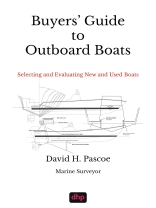This book is totally dedicated to blue water type outboard boats, not jet boats, I/O’s, pontoon boats, bass boats or mega yachts. You won’t be just reading part of it and disregarding the rest. Or paying for something that is irrelevant. What I mean by ‘blue water’ type boats are boats that are sea worthy for heading out into larger bodies of water, not just small lakes and protected bays, etc. Buyers’ Guide to Outboard Boats strives to be relevant to both the novice and more experienced boat owner by addressing the real world issues he faces based on the hundreds, perhaps even thousands questions I’m asked by customers when I do surveys for them. Many people want to totally simplify the matter by asking, ‘Which boat should I buy?’ Ah, if life were only that easy! No one can answer that question since no one but the buyer knows completely what he wants and can afford. Illustrated with over 140 real life photos and drawings New Boats – Used Boats Learn to make your own assessment of boat quality What constitutes good design and bad design Why so many boat builders make serious mistakes. What to look for and how to avoid them. Sea worthiness: The right boat for the right waters. Performance Issues: Why do some boats perform better than others? How to avoid trim problems. Ergonomics: The art of designing products that fit your body size. Nowhere is it more important than with a boat. Navigating the turmoil of the outboard motor market. Choosing the right power options: Outboard, inboard or stern drive. Critical elements of boat rigging Stress cracks: What do they mean? How to research prices and market values.
สารบัญ
Contents
Chapter 1 Basic Considerations for First-time Buyers
Chapter 2 Boat Types & Hull Design Basics
Chapter 3 Hull Construction
Chapter 4 Evaluating Boat Hulls
Chapter 5 Power Options
Chapter 6 Cockpits, Motors and Trim
Chapter 7 Stress Cracks, Finishes and Surface Defects
Chapter 8 Details & Design
Chapter 9 Used Motors
Chapter 10 The New Outboard Motor Market
Chapter 11 Boat Rigging
Chapter 12 Research, Pricing and Shopping
Chapter 13 The Art of the Deal
Introduction – part
This book kicks off with a question that one is unlikely to find in the literature on any manufactured product. Are you a good candidate for being a happy boat owner? I ask it for one very simple reason: Far too may people spend huge sums of money on a boat, only to discover the hard way that they didn’t have time for it, couldn’t really afford it, or just plain don’t like boats as much as they thought they might. Tens of thousands of dollars is a lot to spend on an experiment. For that reason we start by taking a hard look at what boat ownership is all about in the first chapter.
During my three decades of work consulting with boat buyers, it has become abundantly clear to me that the boat buying public needs more information than they are getting. The idea of writing a boat buyers’ guide came to me about 10 years ago, but it has taken me all these years to figure out how to execute it. In large part, the reason for this is because of the huge variety of boats out there. My idea of what would constitute a good buyer’s guide is more than just brief descriptions of the available products; that’s been done. Yet our email box receives thousands of letters from our web site www.yachtsurvey.com every year with prospective buyers asking where they can obtain definitive information on a particular type of boat they are contemplating buying.
Most people are amazed when I tell them that there are no such reliable sources available. Most folks don’t fully grasp the fact that the boat building industry, despite the fact that it produces very large and expensive products, is a marginal industry. As industries go, it is small and highly vulnerable to economic downturns. What that means is that there is not a huge amount of money to be made on producing information, much as one finds with the auto industry.
Name any particular style boat and one can come up with literally hundreds of different builders over the years. There are simply too many small companies building small numbers of boats for anyone to be able to examine, test and provide reliable information about what amounts to hundreds of thousands, if not millions of boats. Ultimately, this means that all anyone has to rely upon when considering a purchase is his own knowledge and ability to evaluate the caliber of a boat. Unless, of course, one chooses to hire a professional to do that.












